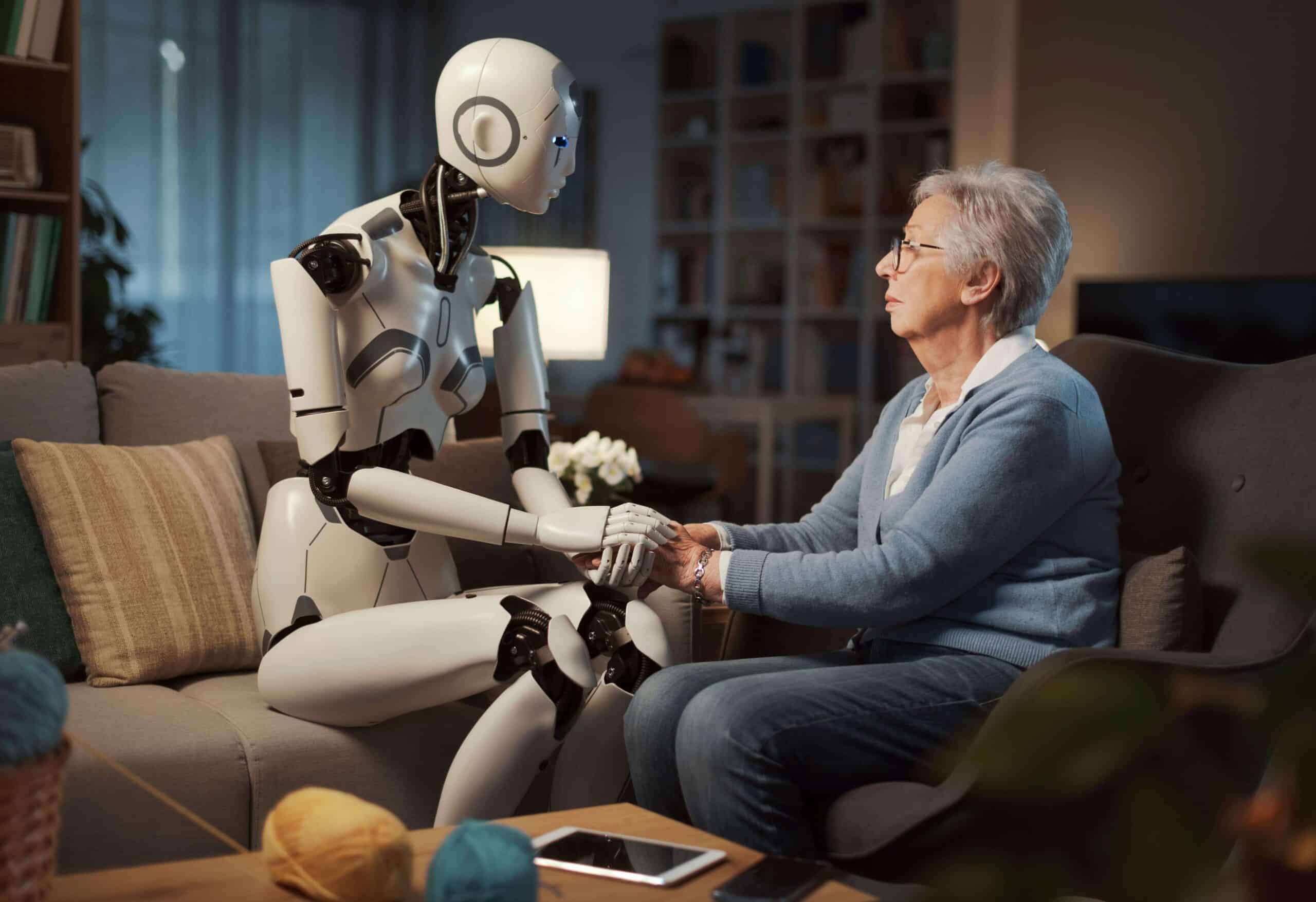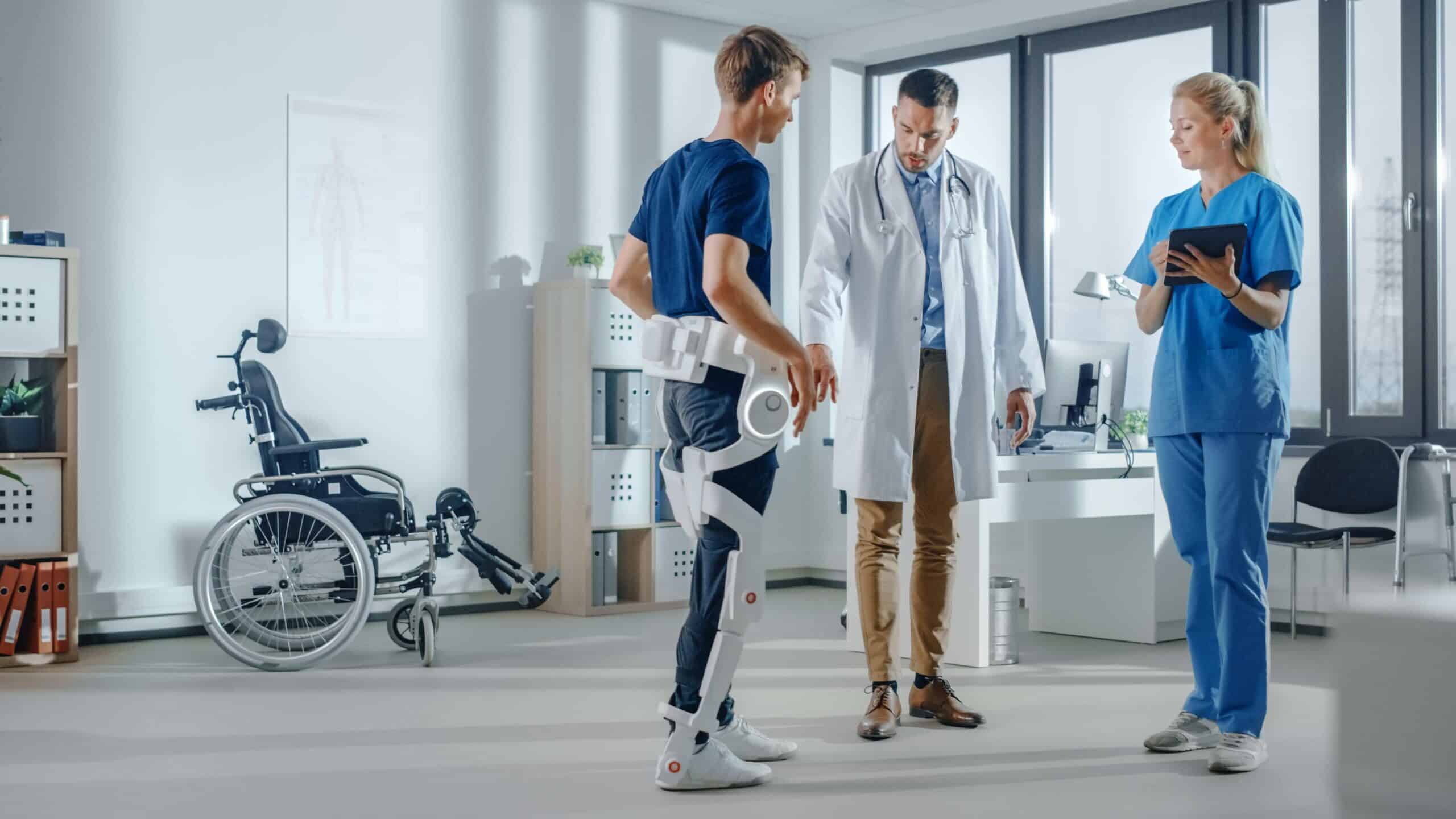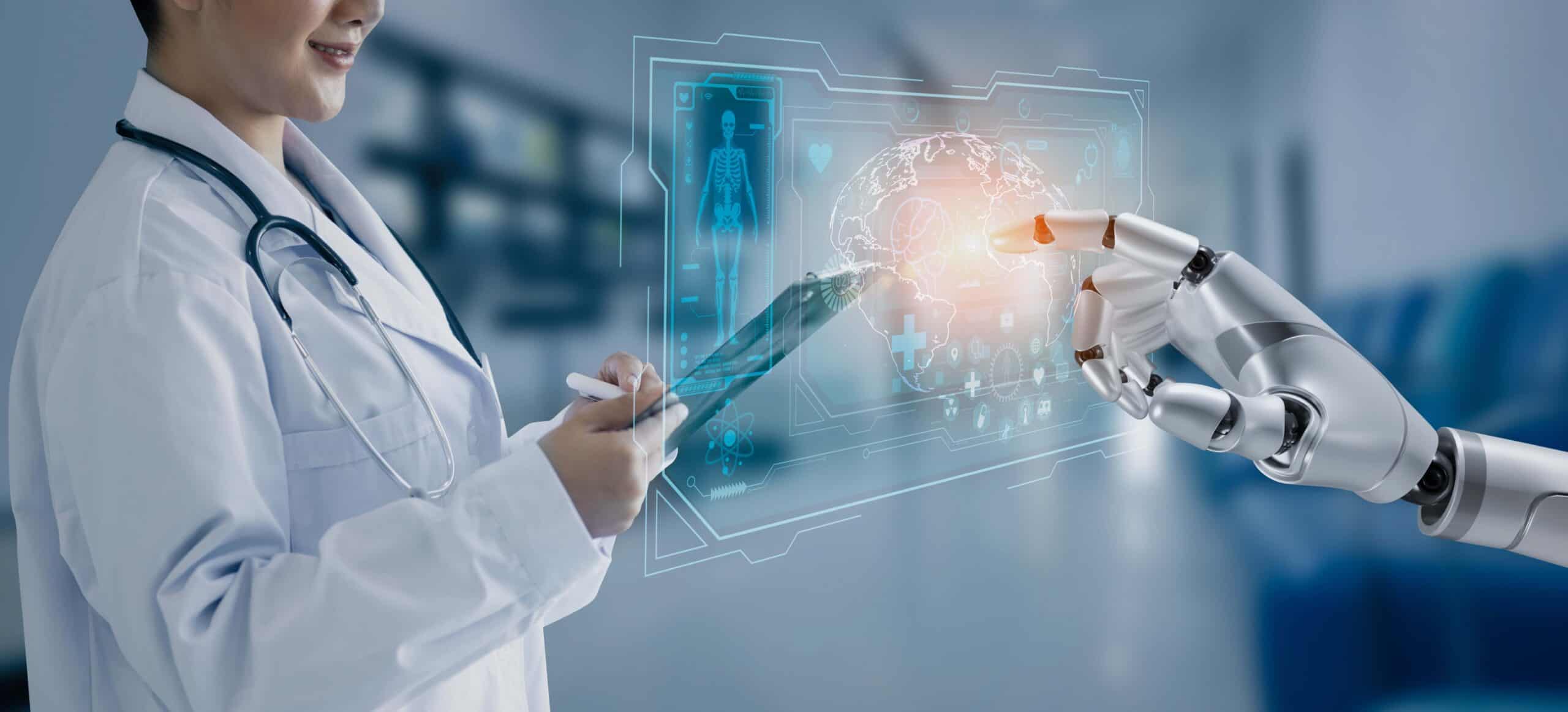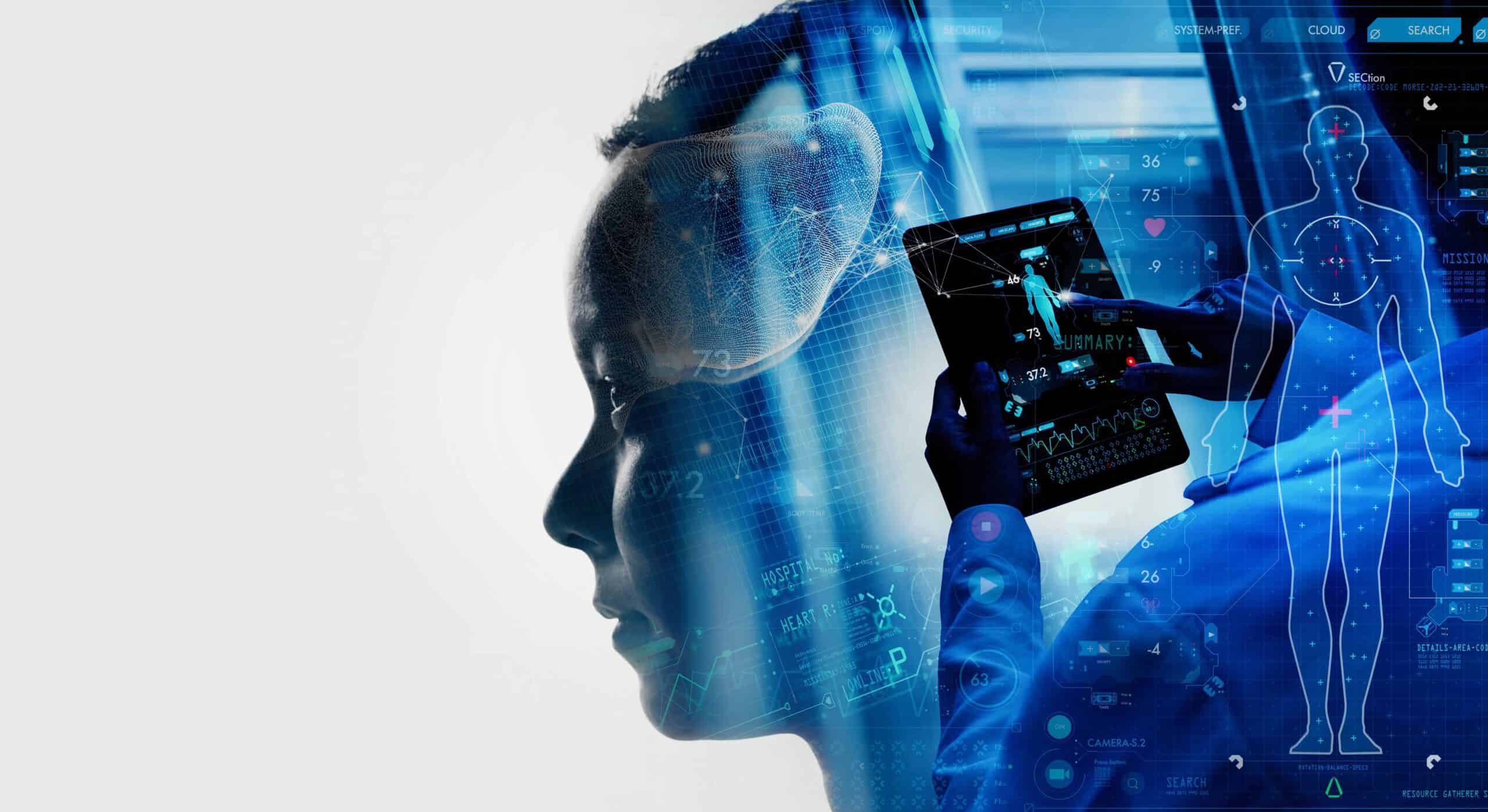- How do neural implants work?
- Treating brain-based disorders
- Restoring high-resolution ‘vision’ in monkeys
- Vagus nerve stimulation explored for chronic inflammatory disorders
- Controlling prosthetics with your mind
- Typing sentences on the computer using only your thoughts
- Tiny BCI implants can potentially enhance physical and cognitive power
- Improving sleep and concentration with non-invasive EEG technology
- We can – but should we?
The rate of new technological developments has been increasing almost exponentially in the past couple of years, and neurotechnology in particular has seen incredible advances. Neurotechnology encompasses the use of brain chips, neural implants, and brain-computer interface technology. Neurotechnology can be applied to enable mind-controlled prostheses, enhance cognitive abilities, and treat neurological dysfunction. It’s a fascinating field, in which human brains are directly ‘wired up’ to technical components, such as computers, electrodes, or smart prostheses, with the aim to either manipulate brain activity by applying optical or electrical stimuli, or to record signals from the brain and ‘translate’ them into control commands. We can expect to come across brain-machine systems more and more frequently in the future, as their potential to improve lives becomes increasingly evident.
How do neural implants work?
A brain implant or neural implant is a technological system that enables communication between the brain and electronic devices. Brain implants are placed inside the brain via a surgical procedure and can be used to monitor brain activity or stimulate parts of the brain. They fire electrical pulses in specific patterns, a bit like Morse code, enabling the modification of brain activity or to record or translate brain activity in order to manipulate a robotic arm or a computer cursor. As brain functions involve processes like thinking, hearing, moving, seeing, feeling, and so on, as well as many involuntary processes, such as the body’s immune, respiratory, inflammatory, and cardiovascular systems, brain implants have the potential to become incredibly powerful medical tools. Basically, brain implants enable scientists to hack into the nervous system. In epilepsy, for instance, brain implants can help neurologists determine in which part of the brain seizures are occurring and trigger assistive measures, such as electrical stimulation to disrupt the progression of the seizure. Brain implants can also help create new sensory pathways in order to assist those who are paralysed to control robotic limbs, or to enable the visually impaired to regain some type of sight.
Treating brain-based disorders
Approximately 150,000 people worldwide have already received a deep brain stimulation (DBS) implant. DBS is one of the more established medical applications of brain implants. It involves the surgical implantation of electrodes deep within certain areas of the brain, where they produce electrical signals to regulate abnormal impulses. The electrodes are controlled by a device placed under the skin in the patient’s chest, called the internal pulse generator (IPG), from which a wire runs under the skin in the shoulder, neck, and head, to connect the device to the electrodes in the brain. DBS is already successfully being used to treat the symptoms of disorders like epilepsy, Parkinson’s, obsessive-compulsive disorder, tinnitus, neuropathic pain, and dystonia. In the future, deep brain stimulation may also be used for Huntington’s disease, Tourette syndrome, and chorea, and to treat chronic pain, cluster headaches, and psychiatric disorders like depression.
Restoring high-resolution ‘vision’ in monkeys
Stimulating the brain via an implant to generate artificial visuals dates back to the 1970s, but existing systems can only generate a small number of artificial ‘pixels’ at a time. In a bid to to restore ‘vision’ in the blind and visually impaired, researchers from the Netherlands Institute for Neuroscience (NIN), led by Dr Pieter Roelfsema, developed high-resolution brain chips and implanted them in the brains of two macaque monkeys to enable the animals to ‘see’ shapes without using their eyes.
To develop brain chips that are more durable and stable than previous implants, the team used new implant production and implantation technologies, as well as cutting-edge microchip fabrication, materials engineering, and microelectronics. The high-resolution neuroprostheses, containing more than 1,000 electrodes, were placed on the visual cortex of the monkeys, where information from the retina is processed. The aim was to test whether it was possible to create images by delivering electrical stimulation through these electrodes. The researchers found that, using their artificial ‘vision’, the monkeys were able to recognise moving dots, lines, and letters.
“Our implant interfaces directly with the brain, bypassing prior stages of visual processing via the eye or the optic nerve. Hence, in the future, such technology could be used for the restoration of low vision in blind people who have suffered injury or degeneration of the retina, eye, or optic nerve, but whose visual cortex remains intact”, says Xing Chen, a postdoctoral researcher in Roelfsema’s team.
Vagus nerve stimulation explored for chronic inflammatory disorders
The vagus nerve connects many important organs to the brain stem. Vagus nerve stimulation (VNS), using neural implants or ‘brain pacemakers’, is a type of neuromodulation that is used in the treatment of drug-resistant epilepsy, migraines, and depression. A stimulator device is implanted under the skin in the chest, from which a wire is wound around the vagus nerve in the neck to send regular, mild pulses of electrical energy to the brain. If the patient is aware of the onset of an epileptic seizure, he or she can swipe a magnet over the device in the chest area to send an extra burst of stimulation to the brain, which may help stop the seizure from fully developing. This exciting VNS technology is currently also being explored as a treatment for things like strokes, heart failure, rheumatoid arthritis, Crohn’s disease, type 2 diabetes, Alzheimer’s disease, obesity, sepsis, lung injury, and various autoimmune and chronic inflammatory disorders. Using VNS provides exciting new opportunities for minimally invasive therapeutic intervention in adults, as well as paediatric patients.
Controlling prosthetics with your mind
While controlling machines with your mind may sound like science fiction, brain-computer interfaces (BCIs) are already making this a reality and it might even become part of everyday life. BCI technology enables a human brain to exchange signals with an external device, enabling us to control machines with our mind. Amputees have already been using BCIs to operate their robotic limbs. By stimulating the nerves in the limb above the amputation, some of these high-tech prosthetics even enable sensory feedback.
“The brains of people who are paralysed can still generate the signals that would normally control movement, but the signal can’t make it past the injury. We’re trying to determine how to use that signal from the brain to allow them to control a prosthetic robotic arm and hand. And in addition to being able to control the arm and hand, we want to give them the ability to feel as though their own hand were touching an object when that prosthetic touches an object”, says Dr John Downey, a staff scientist at the University of Chicago.
Typing sentences on the computer using only your thoughts
And in the future, quadriplegics with brain implants will be able to operate computers and type sentences using only their thoughts. A 65-year old man nicknamed T5, who was paralysed from the neck down after a spinal cord injury in 2007, has been involved in a study by Frank Willett, a research scientist at Stanford University and lead author of the study, which was published in the journal Nature. During the study, two tiny BCIs were implanted into T5’s brain to detect neurons firing in the motor cortex that’s responsible for hand movement.
T5 imagined writing individual letters by hand and the corresponding brain signals were then transmitted to a computer, where an AI algorithm translated them into typed text and displayed them on the screen in front of him. This research could one day be used to help people suffering from strokes, motor neurone disease, and spinal cord injuries. “We are just showing a proof-of-concept demonstration that a handwriting BCI is an exciting and potentially viable approach for restoring communication to people who are severely paralysed. I am hopeful the technology could be feasible for general use within years as opposed to decades”, said Willet.
Tiny BCI implants can potentially enhance physical and cognitive power
The tiny BCI implants that are currently under development are capable of engaging up to a million neurons simultaneously. Some of these implantable sensors are as small as a grain of sand and are also referred to as ‘neural dust’. Many BCI technologies are still in the early stages of development and funded by organisations like DARPA. Some companies have already launched implants that can correct neural communication between the brain and eyes. In the future, these could potentially be used to enhance the cognitive and physical power of, for instance, military personnel.
One company that has been at the forefront of BCI development is Elon Musk’s Neuralink. The company has been developing a device consisting of a minuscule probe that contains more than 3,000 electrodes. These electrodes are connected to threads thinner than a human hair and can monitor the activity of 1,000 brain neurons, after which they are decoded. The short-term goal for Neuralink’s BCI is to treat motor dysfunction or memory loss, such as in diseases like Parkinson’s, dementia, and spinal cord injuries. But what’s also exciting is that Neuralink is testing its BCI for non-medical applications as well.
The company made headlines recently when it announced that a monkey fitted with their brain chip technology had managed to play the videogame Pong with its mind. The monkey had been trained to move a joystick, but with the controller unplugged, the monkey managed to move the paddle simply by thinking about moving its hand. One day, humans may be able to use this technology for day-to-day brain-to-computer communication, controlling phones or opening doors, enhanced mental abilities, the transfer of mental functions to the cloud, telepathic conversations, rewinding and playing back dreams and memories, listening to music inside your head, and – like the monkey – playing video games using only your mind.
Improving sleep and concentration with non-invasive EEG technology
Brain-computer interfaces, while offering a myriad of life-enhancing possibilities, do rely on invasive brain implants. This requires a substantial amount of surgical and medical expertise, and also poses various substantial risks. As an alternative, much less invasive neural interface technologies that can stimulate, train, or regulate brain activity have also seen a significant increase in popularity in recent years. These are based on EEG neurofeedback, involve the use of EEG headsets with electrodes, and are mainly used for improving sleep and encouraging better focus.
UrgoNight helps you sleep
Fuelled by advances in EEG sensing and machine learning technology, more and more companies are exploring neurofeedback technology to monitor the sleeping brain in order to gather insights and provide recommendations to help people sleep better. Neurofeedback technology is already widely used in sleep centres, and can improve night awakenings by 53 per cent, and reduce the time it takes to fall asleep by 40 per cent. French startup UrgoTech, which is part of the Urgo Group, a large organisation that has been around since 1882 and operates in various healthcare fields, has now developed a neurofeedback-equipped headband for use at home. The UrgoNight system consists of an EEG headset with four brain-measuring electrodes and a mobile app. Designed to be used for 15 to 20 minutes during the day, three days a week, the headband guides the user through different neurofeedback games. These games can be controlled via sensory-motor rhythm (SMR) brainwaves that are associated with sleep. The headband trains and strengthens these brainwaves, which ultimately helps reduce sleep problems. The app also includes questionnaires about sleep quality and offers advice on improving sleep, based on cognitive behavioural insomnia therapy.
Neurosity Crown helps increase concentration
Neurosity, a company that works with neuroscientists from the University of California Berkeley, has introduced the Crown: a wearable that makes use of EEG technology, AI, and machine learning to help you increase concentration. As the ability to focus is regulated by the brain’s frontal lobe, the Crown focuses on this region of the brain. The device packs a computer into an ultra-portable, lightweight design that sits comfortably on the crown of your head. It reads brain waves to detect when you’re in the flow and when you’re slacking off – helping you achieve a more focused state of mind.
The device is connected to the accompanying Neurosity Shift app, which is linked to your Spotify account. The app enables you to track your focus over time and gives recommendations on how to reach a state of optimum efficiency. The headset studies which tunes help you focus best, so that it can play productivity-enhancing music. You can set the Crown to automatically mute your notifications, to ensure that you can work without any distractions. “With Crown, Neurosity has invented a whole new category of wearable EEG focus device that lets you take control of your focus no matter where you go. Crown enables users to understand how to shift into focus and stay there”, says Alex Castillo, co-founder at Neurosity.
NextMind enables you to move things with your mind
NextMind, a fast-growing neurotechnology startup and CES 2020 Best of Innovation Award winner, is among an increasing number of startups building non-invasive neural interfaces that rely on machine learning algorithms. The NextMind brain-sensing wearable enables you to control digital technology with ‘direct brain commands’, which means you no longer need to use manual controllers or gamepads. The groundbreaking technology, which is based on scientific research, has been developed to be intuitive and is relatively simple to use. NextMind’s developer kit includes a comb-shaped sensor that is worn on the back of your head, where the brain’s visual cortex is located. The device is hooked up to a brain-computer interface where the signals from the visual cortex are translated into digital commands. You will see hints about which digital objects are mind-enabled. Your active focus on these will enable you to control them with your mind in real time, creating a deeper, more immersive experience between human and computer, AR/VR headsets, and various other devices.
“We’re especially passionate about getting NextMind’s DevKit out to as many developers as possible working in game development and AR/VR applications because we know this technology will be such a literal game changer for the industry due to the fully immersive experiences it enables. Our team is excited to work with the developer community to discover all the ways they can use NextMind to switch on people’s minds, enable telekinetic-type powers and create mind-blowing apps”, said Sid Kouider, founder and CEO of NextMind.
We can – but should we?
Brain-computer interfaces that enable us to use our minds to control objects are becoming big business. In the past couple of years, we’ve seen billions of dollars poured into this and related technologies, such as Elon Musk’s Neuralink and Facebook’s neural interface startup, CTRL-Labs. In fact, according to Grand View Research, the global brain implants market size was valued at $4.6 billion in 2020 and is expected to expand at a compound annual growth rate of 9.1 per cent between 2021 and 2028.
But what does the public think about brain implants and their implications? According to research by Pew Research Centre, most people surveyed (64 per cent) say they are not very excited about the possibility of brain chips giving people improved cognitive abilities or concentration. Some 28 per cent of Americans surveyed say they are very worried about this prospect, while 41 per cent are somewhat worried about this. While 25 per cent are somewhat enthusiastic about the idea of brain enhancement, only 9 per cent are very enthusiastic.
So while the advancement of implantable brain technology is exciting and holds many promises for life-enhancing applications, we also need to be cautious. We have arrived at the stage where we need to carefully consider not only this technology’s potential, but also its implications. Although mind-machine integration can be beneficial in medical applications, and we generally assume that technology is developed for good, we also need to be mindful of potential misuse.
“Our ultimate goal should always be the improvement of quality of life for people who are in need of support, and we will need to be cautious about being primarily driven by financial gain, especially when it comes to commercial applications of this technology”, says futurist and thought leader Richard van Hooijdonk. “And in addition to a myriad of technical and medical obstacles, there are the issues of morality, ethics, and discrimination to consider as well. The have-nots, for instance, may struggle to compete with people who – as a result of their brain implants – have super-human cognition and the ability to control machines with their mind. And of course, we also need to take the safety, security, and privacy concerns of connecting people’s brains to the internet into careful consideration”, Van Hooijdonk concludes.







